LAW
Paper – II
Note : This paper contains fifty (50) objective type questions of two (2) marks each. All questions are compulsory.
1. The Preamble to Constitution of India proclaims that, ‘we, the people of India,’ have established
(1) A Sovereign, Socialist, Democratic, Republic only
(2) A Sovereign, Secular, Democratic, Republic only
(3) A Secular, Socialist, Democratic, Republic only
(4) A Sovereign, Socialist, Secular, Democratic Republic
2. Match List – I with List – II and give the correct answer by using the codes given below :

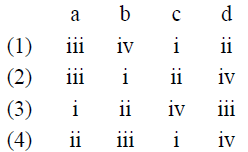
3. Read Assertion (A) and Reason (R) and give the correct answer with the help of codes given below :
Assertion (A) : Under Art. 226 of the Constitution of India the High Court has discretionary remedy to issue writs.
Reason (R) : If the High Court is satisfied that the aggrieved party can have an adequate remedy elsewhere it can refuse to grant writ.
Codes :
(1) (A) and (R) are true and (R) is the correct explanation of (A).
(2) (A) and (R) are true, but (R) is not the correct explanation of (A).
(3) (A) is true, but (R) is false.
(4) (A) is false, but (R) is true.
4. Match List – I with List – II and select the correct answer using the codes given below :

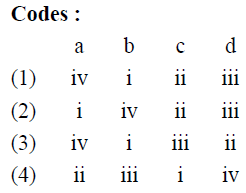
5. “The Fundamental Duties incorporated in Article 51A of the Constitution of India are mere reminder to the citizens, with no enforceability, to ensure their compliance” was said by
(1) Justice J.S. Verma
(2) Justice O. Chinnapa Reddy
(3) Justice Y.V. Chandrachud
(4) Justice P.N. Bhagwati
6. Justice Mukherjee C.J., speaking for the court, stated “that though the executive power is vested in the president, the president is only a formal or constitutional head of the executive. The real power is vested in the Council of Ministers on whose aid and advise the president acts in the exercise of his functions,” in the following case :
(1) U.N.R. Rao v/s. Indira Gandhi
(2) Ram Jawaya Kapur v/s. State of Punjab
(3) Jayantilal Amratlal Shodan v/s. F.N. Rao
(4) Sardarilal v/s. Union of India
7. The right of a person to be appointed as a guardian of his minor children under the personal law is not a fundamental right was decided by the Supreme Court in one of the following cases :
(1) Mohd-Aslam v/s. Union of India
(2) Sahifzada Saiyed Muhammed Amirabbas Abbasi v/s. State of Madyabharat
(3) Khatri v/s. State of Bihar
(4) Mohd. Faruk v/s. State of M.P.
8. According to Austin the positive law has following three attributes :
(1) command, sovereign, obedience
(2) command, sovereign, sanction
(3) command, obedience, sanction
(4) sovereign, obedience, sanction
9. “The movement of progressive societies has hitherto been a movement from status to contract.” This statement is of
(1) Hegel
(2) Savigny
(3) Henry Main
(4) Puchta
10. Match List – I with List – II and give the correct answer by using the codes given below :

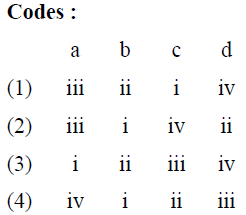
11. Which one of the following is not a theory of corporate personality ?
(1) Fiction Theory
(2) Interest Theory
(3) Bracket Theory
(4) Will Theory
12. ‘A’ has a house and nobody should interfere with the enjoyment of proprietary right over the house. This right is called
(1) Personal right
(2) Imperfect right
(3) Right in rem
(4) Right in personam
13. Match List – I with List – II and give the correct answer by using the codes given below :
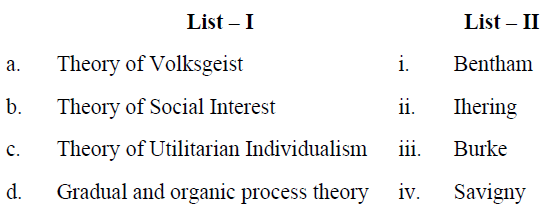
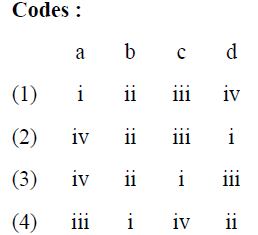
14. Who has remarked that “It is both practically inconvenient and also contrary to the best juristic thought to deny its (International law) legal character” ?
(1) H.L.A. Hart
(2) J.G. Starke
(3) Edward Collins
(4) J.L. Brierly
15. Read both Assertion (A) and Reason (R) and give the correct answer by using the codes given below :
Assertion (A) : ‘Res Judicata’, ‘estoppel’, etc. are examples of the General Principles of Law recognised by civilised states.
Reason (R) : In the case of diversion of water from Muese, the Permanent Court of International justice applied ‘Res Judicata’ and ‘Estoppel’.
Codes :
(1) Both (A) and (R) are correct and (R) is correct explanation of (A).
(2) Both (A) and (R) are correct but (R) is not correct explanation of (A).
(3) (A) is correct, but (R) is wrong.
(4) (A) is wrong, but (R) is correct.
16. Which of the following is not a “theory” propounded to explain the relationship between International Law and Municipal Law ?
(1) Transformation Theory
(2) Delegation Theory
(3) Fiction Theory
(4) Specific Adoption Theory
17. Which of the following statement/s is/are correct ? Answer by using the codes below :
(a) The Charter of the United Nations came into force on October 24, 1945.
(b) The purposes of the United Nations are enshrined in Article 2 of the Charter.
(c) The seventh and the last principle of the United Nations states that nothing contained in present Charter shall authorise the United Nations to intervene in matters which are essentially within domestic jurisdiction of any state.
(d) The provision relating to suspension of a Member finds mention in Article 3 of the charter.
Codes :
(1) Only (a) and (c) are correct.
(2) (a), (b) and (c) are correct.
(3) (b), (c) and (d) are correct.
(4) (a), (b), (c) and (d) all are correct.
18. Which of the following statement/s is/are correct ? Answer by using the codes below :
(a) “Mediation” is not “pacific means” of settlement of International Disputes.
(b) “Pious Fund Case” is an important decision given by the Permanent Court of Arbitration.
(c) “Retorsion” is a compulsive or ‘coercive’ means of settlement of international Disputes.
(d) A leading case on “Reprisal” is the “Naulilaa Incident”.
Codes :
(1) Only (b) is correct.
(2) (a), (b) and (c) are correct.
(3) (b), (c) and (d) are only correct.
(4) (a), (b), (c) and (d) all are correct.
19. Which of the following statement/s is/are incorrect ? Answer by using the codes below :
(a) The Commission on Human Rights was established by the Economic and Social Council in February, 1946.
(b) The General Assembly decided to replace U.N. Human Right Commission by Human Right Council Vide Resolution 60/251 of 15 March, 2006.
(c) The Human Right Council concluded its first session at Hague on 30 June, 2007.
(d) The Universal Declaration of Human Rights was adopted by the General Assembly by a vote of 48 to nil with eight abstentions.
Codes :
(1) Only (c) is incorrect.
(2) (a), (b) and (c) are incorrect.
(3) (b), (c) and (d) are incorrect.
(4) (a), (b), (c) and (d) are incorrect.
20. Read the following statements and answer with the help of codes given below :
(a) Two persons are said to be related to each other by full blood when they are descended from a common ancestor by the same wife.
(b) Two persons are said to be related to each other by uterine blood when they are descended from a common ancestress but by different husbands.
(c) Two persons are said to be related to each other by half blood when they are descended from a common ancestor by the same wife.
(d) Two persons are said to be related to each other by half blood when they are descended from a common ancestor but by different wives.
Codes :
(1) (a) and (b) are correct, but (c) and (d) are incorrect.
(2) (a), (b) and (d) are correct, but (c) is incorrect.
(3) (d) and (b) are correct, but (c) and (a) are incorrect.
(4) (b) and (c) are correct, but (a) and (d) are incorrect.
21. A person shall not be treated as Buddhist under sec. 2(1) of the Hindu Marriage Act, 1955, if :
(1) Both of his parents were Buddhists.
(2) His father was Christian, mother was Buddhist and he was brought up as Buddhist child.
(3) His father was Christian, mother was Buddhist and he was brought up as Christian child.
(4) He was a Muslim and has converted to Buddhist religion.
22. Ancient sources of Hindu law are :
(1) Custom, Sruti, Precedent
(2) Sruti, Vedas, Custom, Legislation
(3) Smritis, Custom, Precedent
(4) Sruti, Smritis, Custom, Digests etc.
23. The Muslim Personal Law (Shariat) Application Act 1937 is applicable to all kinds of property except
(1) Agricultural land, testamentary succession and Charities other than wakfs.
(2) Testamentary succession and charities other than wakfs only.
(3) Agricultural land and testamentary succession only.
(4) Agricultural land and charities other than wakfs only.
24. Match List – I with List – II under the Hindu Marriage Act, 1955 and give the correct answer using the codes given below :

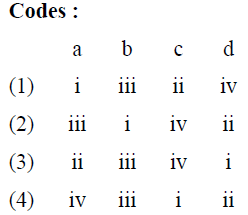
25. Presently the Hindu Marriage Act, 1955 recognizes the following theories of divorce :
(1) Fault and Mutual Consent
(2) Mutual Consent and Breakdown of Marriage
(3) Fault, Breakdown of Marriage, Mutual Consent and Customary
(4) Fault, Irretrievable Breakdown of Marriage and Mutual Consent
26. Talaq ahsan is
(1) Irrevocable
(2) Revocable during the tuhr in which it has been pronounced
(3) Revocable until the next successive tuhr
(4) Revocable during the period of iddat
27. Match List – I with List – II and select the correct answer using the codes given below :
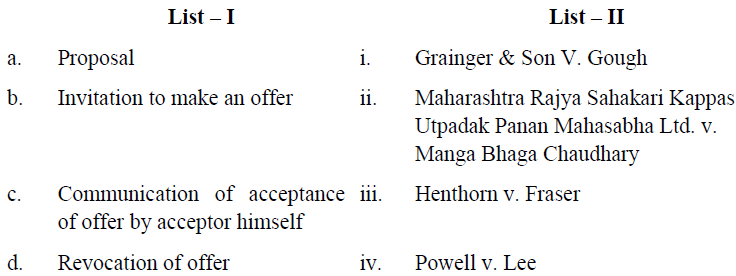

28. Read Assertion (A) and Reason (R) and answer using codes given below :
Assertion (A) : An agreement made with consideration is void unless it is in writing and registered.
Reason (R) : Because Section 25(1) of the Indian Contract Act stipulates so.
Codes :
(1) Both (A) and (R) are right and (R) is correct reason for (A).
(2) Both (A) and (R) are wrong.
(3) (A) is right, but (R) is wrong.
(4) (R) is right, but (A) is wrong.
29. In which one of the following cases doctrine of frustration was laid down ?
(1) BOI Finance Ltd. v. Custodian
(2) Orissa Textile Mills Ltd. v. Ganesh Das
(3) Sachidananda Patnaik v. G.P. & Co.
(4) Taylor v. Caldwell
30. Which of the following statement is correct ?
(1) A person who wrongfully rescinds a contract is entitled to compensation for any damage which he has sustained through the non-fulfilment of the contract.
(2) A person who rightfully rescinds a contract is not entitled to compensation for any damage which he has sustained through the non-fulfilment of the contract.
(3) A person who rightfully rescinds a contract is entitled to compensation for any damage which he has sustained through the non-fulfilment of the contract
(4) A person who rightfully rescinds a contract is entitled to compensation for any damage which he has not sustained through the non-fulfilment of the contract.
31. Every person is competent to contract
(1) who is of the age of minority according to law to which he is subject, and who is of sound mind, and is not disqualified from contracting by any law to which he is subject.
(2) who is of the age of majority according to law to which he is not subject, and who is of sound mind, and is not disqualified from contracting by any law to which he is subject.
(3) who is of the age of majority according to law to which he is subject, and who is of sound mind, and is not qualified from contracting by any law to which he is subject.
(4) who is of the age of majority according to law to which he is subject, and who is of sound mind, and is not disqualified from contracting by any law to which he is subject.
32. Match List – I with List – II and select the correct answer using the codes given below :

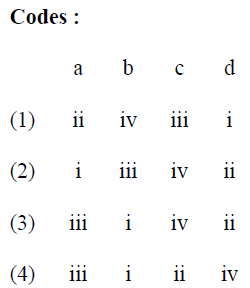
33. Read Assertion (A) and Reason (R) and answer using codes given below :
Assertion (A) : Compensation is recoverable for any loss or damage which the parties knew at the time of the contract as unlikely to result from the breach of the contract.
Reason (R) : Because above rule is laid down in Hadley v. Baxendale case.
Codes :
(1) Both (A) and (R) are correct and (R) is correct reason for (A).
(2) Both (A) and (R) are wrong.
(3) (A) is right, but (R) is wrong.
(4) (R) is right, but (A) is wrong.
34. Match List – I (Name of case) with List – II (Decision of case) by using codes below :
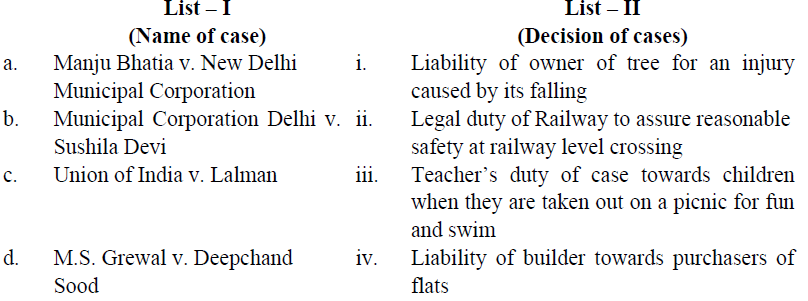
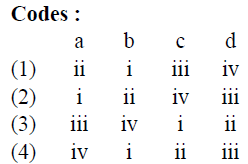
35. Read Assertion (A) and Reason (R) and answer using codes given below :
Assertion (A) : Acts of state are directed against another sovereign state or its sovereign personally or its subjects.
Reason (R) : Acts of executive Government in the name of President in normal course of administration are acts of state and are not open to judicial scrutiny.
Codes :
(1) Both (A) and (R) are correct and (R) is correct reason of (A).
(2) Both (A) and (R) are correct, but (R) is not correct reason of (A).
(3) (A) is right, but (R) is wrong.
(4) (R) is right, but (A) is wrong.
36. Which of the following is correct ? Answer by using the codes below :
(a) Corporation is vicariously liable for acts done by its employees.
(b) Minor is liable for the torts committed by him.
(c) Wife is liable under law of torts to her husband if she negligently fractures his legs.
(d) Tort committed by any partner in the ordinary course of business of firm all other partners are liable.
Codes :
(1) (a), (b), (c) and (d)
(2) (a), (b) and (c)
(3) (a), (b) and (d)
(4) (a) and (d)
37. In which case the principle ‘ubi jin ibi remedium’ was recognized ?
(1) Rylands v. Flecher
(2) Asbhy v. White
(3) Ashdown v. Samuel Williams
(4) Pema Chibber v. Union of India
38. State Government may notify that State Commission may perform its function at other places other than state capital. Who needs to be consulted by the State Government for such notification under Consumer Protection Act ?
(1) Central Government
(2) National Commission
(3) State Commission
(4) State Commission and High Court
39. Who among the following cannot file a complaint before the District Forum under Section 12 of the Consumer Protection Act ?
(1) One consumer and not more than one consumer
(2) Any recognized consumer association
(3) Central and State Government
(4) One or more consumers
40. ‘The degree of cogence need not reach certainity but it must carry a high degree of probability.’
As per the statement answer using codes as to in which of the situations, in sequential order the principle of natural justice is applied :
Codes :
(a) Alibi
(b) Self-incrimination
(c) Presumption of innocence
(d) Strict liability
Sequence of order :
(1) (a), (b), (c), (d)
(2) (d), (c), (a), (b)
(3) (c), (b), (a), (d)
(4) (b), (c), (d), (a)
41. The principle of ‘Quod necessitas non habet leegen’ is applied in circumstances of
(1) an act done in order to avoid consequence
(2) in a little harm that resulted in the consequence
(3) a harm resulted in order to do another evil
(4) self-preservation
42. Aggravated abetment can be found within the public
(1) when the act was done by any one of the ten or more members present.
(2) when the act was done by one of the seven members while collecting funds from other public.
(3) while a person affixing a poster on the wall specially called attention of an assembly of five persons to protest against police excesses.
(4) when an un-named member of a fluctuating population incite others to undertake a strike to stop train movement.
43. In which of the matters it was held that disclosure of identity of victim either by printing or publishing will not amount to penal liability ?
(1) In a judgement given by the Session’s Judge on the ground of social victimisation.
(2) In a judgement given by the High Court on the ground of Ostracism.
(3) In a judgement given either by High Court or Supreme Court on the ground of preventing social victimisation or contracism.
(4) In a judgement given by the Supreme Court on the ground of prevention from social victimisation.
44. Read Assertion (A) and Reason (R) and answer the reasonableness using the ‘code’ given below :
Assertion (A) : Section 304-A is directed at offences outside the range of Sections 299 and 300.
Reason (R) : It contemplates those acts into which neither intention nor knowledge enters. Codes :
(1) Both (A) and (R) are correct as the act results from rash and negligence act.
(2) (A) is correct as certain acts are unjustifiable while (R) is not the correct reason as it falls short of culpable homicide.
(3) (R) is correct while (A) is incorrect application to the rule of culpable homicide to cause murder.
(4) Both (A) and (R) are incorrect statement as to imposing penalty.
45. Read Assertion (A) and Reason (R) and answer using codes given below :
Assertion (A) : Multiple Trade Unions in industries and the consequential necessity for selecting one as the recognised union by the management devising a method on democratic principles is necessary.
Reason (R) : The Union which represents the largest number of workmen working in the undertaking must acquire the status as that would be in tune with the concept of Industrial democracy.
Codes :
(1) (A) and (R) are correct and (R) is the correct explanation of (A).
(2) (A) and (R) are correct and (R) is not the correct explanation of (A).
(3) (A) is correct, but (R) is wrong.
(4) (A) is wrong, but (R) is right.
46. “The working class unfamiliar with the sophistications of definitions and shower of decisions, unable to secure expert legal opinion, what with poverty pricing them out of justice market and denying them the staying power to withstand the multi-decked litigative process, defacto is denied social justice if legal drafting is vagarious, definitions indefinite and court rulings contradictory.”
The above remarks were made in support of an expensive definition of “Industry” by one of the following justice :
(1) Justice O. Chinnappa Reddy
(2) Justice V.R. Krishna Iyer
(3) Justice Gajendragadkar
(4) S.P. Bharucha
47. Which one of the following is incorrect ?
(1) Workman whose name is borne on the muster rolls of an industrial establishment and who has completed one year of continuous service under an employer is laid off, whether continuously or intermittently shall be paid by the employer for all days during which he is so laid off except for such weekly holidays.
(2) Termination on the ground of misconduct or continued ill health of a workman is not a retrenchment.
(3) Lock-out means the permanent closing of a place of employment, or the total suspension or the refusal by an employer to continue to employ any number of persons employed.
(4) The right to close down the business, trade or undertaking is subject to payment of compensation to the workers engaged in the business immediately before the closure.
48. Match List – I with List –II and select the correct answer using the codes given below :
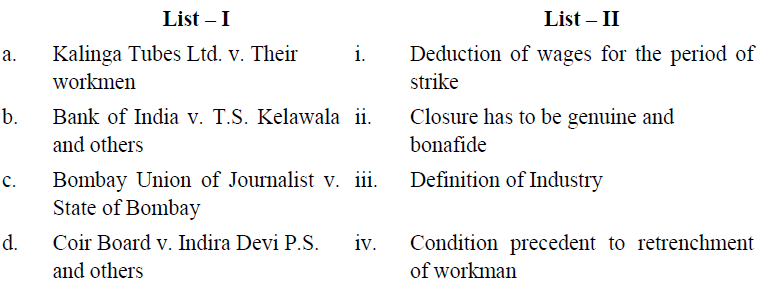
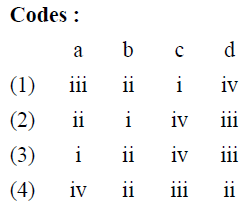
49. Reference of an Industrial Dispute, the subject matter of which is covered by a settlement as defined in Section 2(P) of the Act would be :
(1) valid during the operation of such settlement
(2) invalid during the operation of such settlement
(3) valid and subject to the importance of Industrial Dispute
(4) voidable at the option of the parties to the dispute during the operation of such settlement
50. Read Assertion (A) and Reason (R) and answer using codes given below :
Assertion (A) : The retention of Industrial Adjudication is necessary till all Trade Unions attain sufficient strength to bargain with employers, from a position of equality.
Reason (R) : Collective Bargaining presently provides only lip services, whereas in practice it has perpetuated Adjudication.
Codes :
(1) (A) and (R) are correct and (R) is the correct explanation of (A).
(2) (A) and (R) are correct, but (R) is not the correct explanation of (A).
(3) (A) is correct, but (R) is wrong.
(4) (A) is wrong, but (R) is right.
Latest Govt Job & Exam Updates: